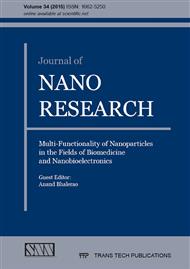[1]
Lee, Ji Yeong; Kim, Jin Soo; Hyeok An, Kay; Lee, Kyu; Kim, Dong Young; Bae, Dong Jae; Lee, Young Hee; Source: Journal of Nanoscience and Nanotechnology, Volume 5, Number 7, July 2005 , pp.1045-1049(5); Publisher: American Scientific Publishers.
DOI: 10.1109/itcc.2000.844254
Google Scholar
[2]
Sensors ISSN 1424-8220 © 2007 by MDPI Review Raman Spectroscopy Cell-based Biosensors Ioan Notingher University of Nottingham, School of Physics and Astronomy, University Park, Nottingham NG7 2RD, UK.
DOI: 10.21861/hgg.2019.81.02.01
Google Scholar
[3]
SCIENCE AND TECHNOLOGY OF THE TWENTY-FIRST CENTURY: Synthesis, Properties, and Applications of Carbon Nanotubes, Annual Review of MaterialsResearch, 08/(2003).
Google Scholar
[4]
Jenny Hilding. Dispersion of Carbon Nanotubes in Liquids, Journal of Dispersion Science andTechnology, (2003).
Google Scholar
[5]
Ordoñez-Casanova, Elsa, Manuel Román- Aguirre, Alfredo Aguilar-Elguezabal, and Francisco Espinosa-Magaña. Synthesis of Carbon Nanotubes of Few Walls Using Aliphatic Alcohols as a Carbon Source, Materials, (2013).
DOI: 10.3390/ma6062534
Google Scholar
[6]
Rosen, Characteristic Features of Surfactants, Surfactants and Interfacial PhenomenaRosen/Surfactants 4E, (2012).
DOI: 10.1002/9781118228920.ch1
Google Scholar
[7]
Yan, X. Laser heating effect on Raman spectra of styrene-butadiene rubber/multiwalled carbon 29 nanotubes nanocomposites, Chemical PhysicsLetters, 20120127.
Google Scholar
[8]
Kalbac, M. The influence of doping on the Raman intensity of the D band in single walledcarbon nanotubes, Carbon, 201003.
Google Scholar
[9]
Jain, A.K. Carbohydrate-conjugated multi walled carbon nanotubes: development and characterization, Nanomedicine: Nanotechnology, Biology, and Medicine, 200912.
Google Scholar
[10]
Duhan, Surender, and Vijay Tomer. Advanced Electronics: Looking beyond Silicon, AdvancedEnergy Materials, (2014).
Google Scholar
[11]
Shamsuddin, Shahidah Arina, Nur Hamidah Abdul Halim, Nazree Deraman, and Uda Hashim. The characterization study of functionalized multi-wall carbon nanotubes purified by acid oxidation, 2011 IEEE Regional Symposium on Micro and Nano Electronics, (2011).
DOI: 10.1109/rsm.2011.6088339
Google Scholar
[12]
Notingher, Ioan. Raman Spectroscopy Cell basedBiosensors, Sensors, (2007).
Google Scholar
[13]
PluronicF-68 enhances the Nanoparticle-Cell Interaction; Sci Pharm. 2009; 77: 179 doi: 10. 3797/scipharm. oephg. 21. SL-12.
Google Scholar


